Altitude Tweak to Boost Starlink Broadband Speeds and Latency

Global ISP Starlink (SpaceX) has secured approval from the FCC to make several tweaks to their new mega constellation of Low Earth Orbit (LEO) based ultrafast broadband satellites, which among other things will result in improved internet speeds and latency for customers across the world and UK.
At present SpaceX has already launched 1,374 LEOs into orbit (space) around the earth and their initial ambition is to deploy a total of 4,425 by 2024, which could potentially be followed by up to 12,000 at a later date (possibly late 2026). The service has already gone live in the USA, Canada, UK and is now extending into Europe, albeit still technically in a pre-launch beta phase.
Customers in the UK typically pay £89 per month for the service, plus £54 for shipping and £439 for the kit (dish, router etc.). For that you can expect unlimited usage, good latency times of 20-40ms, downloads of between 50-150Mbps and uploads of c.20Mbps. But connection drops remain a problem during the beta phase.
Advertisement
SpaceX’s CEO, Elon Musk, has previously said that he expects end-user download speeds to rise as the network grows, and they could hit around 300Mbps by the end of 2021 (here). In fact a number of customers in the USA have already experienced this. But adding more LEOs isn’t the only way to boost performance, you can also make tweaks to the existing network and future plan for how they’re positioned.
What’s Changing?
Specifically, the FCC has agreed to make several changes to Starlink’s constellation, which can be summarised as follows.
Key Starlink Licence Modifications
➤ Reduce the number of satellites from 4,409 to 4,408.
➤ Reduce the primary operational altitude specified for 2,814 satellites, to change it from the 1,100-1,300km range to the 540-570km range. We note that the FCC had previously (2019) only allowed Starlink to operate 1,584 of their LEOs at 550km.
➤ Modifying the minimum earth station elevation angle for both user beams and gateway beams, and by including in the license authority to conduct launch and early orbit phase (LEOP) operations and payload testing during orbit-raising and deorbit of its satellites.
Specifically, SpaceX is authorized to operate with earth station elevation angles as low as 25 degrees for user terminals and gateways, and for gateways in the polar regions it is authorized to operate with earth station elevation angles as low as 5 degrees.
A number of rival operators including Viasat, SES, Hughes, Dish Network, OneWeb, Kepler and Kuiper (Amazon) had lodged opposition to the proposed change, with many arguing that it risked creating more interference for their own satellites and related systems. But the FCC rejected those concerns and instead concluded that “this modification does not create significant interference problems.”
FCC Statement
We conclude that grant of the SpaceX Third Modification Application is in the public interest. Based on our review, we agree with SpaceX that the modification will improve the experience for users of the SpaceX service, including in often-underserved polar regions. We conclude that the lower elevation angle of its earth station antennas and lower altitude of its satellites enables a better user experience by improving speeds and latency.
Additionally, a number of the satellites being deployed pursuant to this modification are satellites orbiting at high inclinations, which are uniquely able to provide improved service to higher latitude regions.
As noted below, deployment to a lower altitude guarantees removal of satellites from orbit within a relatively short period of time, and consequently has beneficial effects with respect to orbital debris mitigation.
Despite how it may seem, the changes do also bring some potential benefits to Starlink’s rivals. For example, the company will now need to assess the cumulative collision risk presented by their entire constellation, while also ensuring that they’re reliable and safe, which could potentially throw up a few obstacles further down the line.
Advertisement
The changes also require some of Starlink’s satellites (i.e. those at the upper range of SpaceX’s selected altitudes, operating with a nominal altitude of 560km or 570km) to remain below 580km and accept additional interference resulting from its redesign (Amazon plans to use orbits as low as 590km in its Kuiper constellation). In other words, if Starlink’s redesign creates interference for a rival operator, like Kuiper, then the burden is on SpaceX to fix it or accept any impact on its services.
We should point out that Starlink’s future constellation will operate at a variety of different altitudes, each of which require different considerations. Back in 2018 they were granted permission to launch another 7,518 satellites at altitudes of just 335km to 346km.
The company is also seeking approval for 30,000 more LEOs at altitudes ranging from 328km to 614km, which is likely to send shivers down the spines of anybody involved in observational science (e.g. telescopes) or concerned about the rising risk from collisions (the “space junk” problem).
Mark is a professional technology writer, IT consultant and computer engineer from Dorset (England), he also founded ISPreview in 1999 and enjoys analysing the latest telecoms and broadband developments. Find me on X (Twitter), Mastodon, Facebook, BlueSky, Threads.net and Linkedin.
« Full Fibre Could Bring 1 Million UK People Back into Workforce






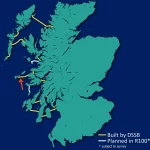

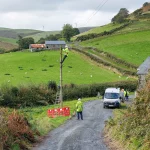



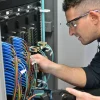
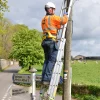

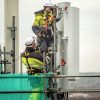






































Apparently 150km is an achievable orbit, so there is room in it for more improvements in the future too.
The lower the orbit, the bigger the power budget to prevent it from decaying, as the atmospheric drag increases exponentially, so although it’s possible I doubt they be in a rush to park their birds that low 🙂
That is technically true, but at very low altitudes (like 150km) satellites can only stay in orbit for weeks/months, which is not sustainable for SpaceX who will want the satellites to stay in orbit for many years.
Very low orbits also require much greater numbers of satellites to provide a high coverage area on earth. I wouldn’t expect SpaceX to go much lower than 540km by design, unless Elon makes some breakthrough in satellite design (possible I guess).
All these satellites in space are going to end up causing world wide problems when they start crashing with each other, and we’ve already had a near miss. There is no reason why the Internet has to be provided by many tens of thousands of satellites that keep needing to be replaced. There are ground based methods of providing connectivity that billions of people are already using that are safer, greener and faster, and the money should be spent on expanding those networks.
Once this junk is in space it will be impossible to clean it up. What happens if the companies involved go bust or decide it isn’t profitable and just abandoned it all?
“There are ground based methods of providing connectivity that billions of people are already using that are safer, greener and faster.”
Supply and demand. Many people in rural communities still struggle to get decent speeds and, for all the years spent investing in such networks, quite a few remain in that situation today.
“Once this junk is in space it will be impossible to clean it up. What happens if the companies involved go bust or decide it isn’t profitable and just abandoned it all?”
LEOs that fail are pulled down by Earths natural gravity within the space of a few short years.
A bigger risk is perhaps from a powerful solar flare that ends up destroying many of them, as well as bigger satellites and ground based systems.
@Phil, for the love of everything, don’t you think some rather clever people are aware of that problem?
Also, what near miss are you referring to? I think I read about ESA referring recently to a 20% chance of a near miss that didn’t actually happen, is that the one?
It has been stated TIME AND AGAIN that LEO satellites need active thrust to remain in orbit, else it just decays and the satellites burn up on reentry.
Honestly, please just consider the possibility that people MAY be aware of the problems that you’re worried about and may have already mitigated for them.
Also, and I apologise if the following is a statement of the obvious, orbits are big empty spaces. Seriously big. Imagine the whole surface of the earth but bigger, and it gets bigger the further out you go.
It’s not a traffic jam packed with “stuff” up there.
Cue the space environmentalists…
If the near miss, was the one with OneWeb, then it seems like the Oneweb guy pushing the story was more than a little bit fast and lose with the truth to the WSJ.
Second section down
https://arstechnica.com/information-technology/2021/04/spacex-says-oneweb-spread-false-story-of-near-miss-satellite-collision/
Well, where I am m waiting to see if Wessex Internet, Starlink or 5G get to my area first. And currently I’d suspect Starlink will, for a price though, still this is good news for rural areas.
If you’re internet is really that bad that you’re considering starlink then I applaud you. I checked the other day and it is available in the north east but with the prospect of moving in a year it’s off-putting for cost.
5G in the many places I’ve tried it has been a let down at around 40-50Mbps which is better then my broadband but not exactly stellar.
I am a beta tester for Starlink based in the New Forest. I have had it since Feb. I had spent the last 5 years complaining to BT and Openreach about our dire internet and phone line. We got 7mb dl and 0.4mb ul. The USO was a waste of time (a quote of 30k) and our landline connection was dreadful. I now get 200mb dl and 40mb up and whilst there are the odd drops for a few seconds every day (beta downtime), these are far less frequent than they were. We have now cancelled our BT internet service and landline.
Starlink has truly changed our lives. It was a shame that it wasn’t around at the start of lockdown – WFH was a nightmare and my Son missed out on huge amounts of schooling as we couldn’t maintain a Zoom call due to the poor wired internet connection. I hope Starlink give Openreach a bloody nose.
Blaming Openreach for your residential and schooling choices is a bit rich.
People relocate routinely to facilitate their kids education – but not you… it’s Openreach’s job to deal with your shortcomings?
7Mb download? Luxury! You should come to Wales, where I am, there is literally NOTHING that could be defined as “broadband”. If you could get a connection at all, it was 0.1-0.2Mbps. On Starlink for the last 6 weeks, it’s bloody brilliant. Our community had been on negotiations with OpenRetch for the last 8 months too get a plan for fibre (we were originally promised it in 2015, then 2016, then “definitely” in 2017, then…. Never). We’ve only just been sent a plan! OpenRetch are a lazy, greedy and badly run private monopoly who can’t be arsed to provide the infrastructure that it’s their responsibility to maintain. I hope Starlink and their ilk eat their lunch. I’ve abandoned the land line completely as well, tho’ that was appallingly bad to, so good riddance too bad rubbish!
Meanwhile, in other parts of rural Wales and of course the UK too, Openreach have FTTP which will knock the spots off of anything the satellite boys try to do.
As it turns out, rolling out new infrastructure in challenging environments might well take a bit longer than spaffing up a few satellites. It hasn’t turned out well for you, sure, but many more have had an upgrade.
People like to assume that their own personal situation is endemic of the entire country – the other classic example of this is when people say $mobile_network is crap because it doesn’t work in every room of their house.
200Mbps on a very very very lightly loaded network, while better than existing satellite systems, isn’t all that impressive really. If I was the only option I’d absolutely take it, but I’d still jump ship the moment the fibre gets to me, and since I have a reliable VDSL connection I don’t see the point (starlink costs a lot more for one thing!)
@Bill I am not sure if you are joking or just being a massive bellend?
I think it’s worth saying that Starlink gives people a choice, especially in remote areas, so it’s not worth getting into a pissing contest about the pro’s and cons. If the users are happy, then it should be celebrated.
If in time another provider comes a long and provides FTTP to the home to that user, and it gives the end user a choice, then that’s even better.
Those speeds are shot for the price virgin media fibre 10ms 100-200mbs for 30 quid amonth unlimited usage why woupdnyou pay 90quid for 20-40ms for 100< mbps